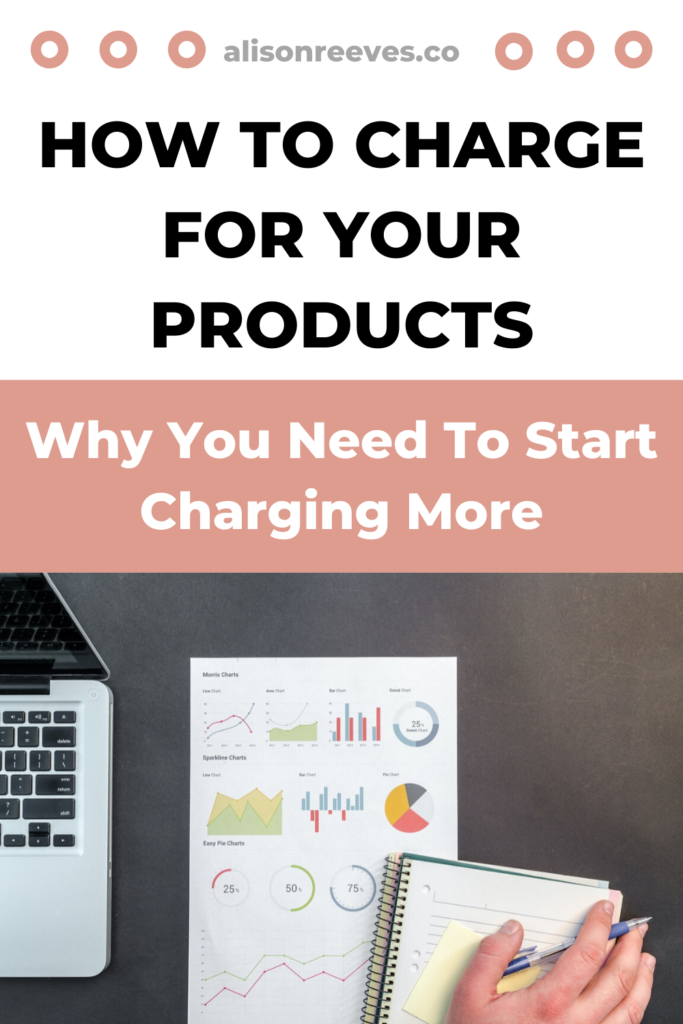Think you know how to price your products? If you don’t start charging more, you’re never going to reach your goals.
And if you ignore what’s going on in the world around you and don’t adjust your messaging, you’re going to fall behind.
Let me explain.
My clients struggle with how to price their products over and over. It is a mindset battle. And if you do not find a way to shift your mindset, you will be stuck where you are.
Even people who think knowing how to price your products will not be an issue for them are surprised when we get down to it.
It’s easy to feel uncomfortable when you charge other people for something that feels easy to you.
And while we’re on the mindset stuff, let’s not ignore the elephant in the room that a lot of us are facing new fears, new unknowns and new places we need to problem solve in our businesses and the evolving world we are facing.
In this article covering how price your products, I want to go, in depth, over:
- How to pivot so you can maintain or build your business
- Why you need to charge more for what you’re doing
- How much to charge
- How to increase value
Table of Contents
ToggleFirst, Let’s Just Talk Simple Numbers
One of my clients spent weeks putting everything she had into her course. It was amazing, and we were confident it would help change lives. She put her blood, sweat and tears into a course that she wanted as accessible as possible… She made it at an extremely low cost.
And her launch was really successful! Her sales to her list doubled the average for a typical launch and she sold several units! …
But because the product was so low cost, she made less than $100 for what any online entrepreneur would categorize as a “successful launch.” Not knowing how to price your products made her hard effort seem fruitless.
So if your goals are financial, you’re going to have a hard time. It’s possible to make great income with low cost products, but you have to have a really large audience to make it work.
If your goals are about helping people… low cost might not get you there either and here’s why:
When people pay low cost, their investment is low because there wasn’t enough risk for them to be motivated to take action. If I spend $10 on a ring, I’m a lot more calm losing it than I am losing $1,000 ring, right?
We’re so afraid of charging more because we don’t want fewer people to buy that we never raise our prices in a way that is meaningful to us or serves our people well. But knowing how to price your products is about being confident in the value that your transformation provides.
Money motivates people to participate in their own transformation. And if they don’t have to pay enough for it, then they won’t be motivated enough to charge. And you won’t be effective.
So if you want to change the world, you have to charge for the transformation.
Want to read more about making big goals? Here’s why you need to aim higher…
Be Comfortable With Pivoting
This is a really scary time, and things are changing fast.
The biggest mistake you can make is to not acknowledge the change.
We have to change the way that we are talking about things. We have to talk about what is going on. If we keep talking about the same things, and talking about our products in the same way people will be turned off.
People have different fears than they did 2 weeks ago, different pain points. They need their fears and thoughts to be recognized.
Before, when I talked about making money blogging, my value propositions might be that I can help them get stuck when they are struggling, the courses they bought have not worked, you need help increasing income and traffic. NOW my value propositions are that I can help you make a non profitable business profitable or create backup for job security with extra income.
These are just some examples. I didn’t have to change the product. I just had to change the way I thought about it to reflect what my clients need right now.
6 Reasons Why You Should Charge More
Wanting to make more money is only one reason to start charging more.
(And by the way- it’s okay to want to make more money! Somewhere along the way I developed an idea that money was evil, or wanting to be comfortable and wealthy was selfish… but it absolutely is not. It is okay for me to want to be make a certain amount of money and live a certain way. And no amount of me feeling guilty for a good circumstance is going to feed starving children in China any faster. So stop making yourself feel guilty and celebrate yourself and your financial accomplishments.)
But there are other reasons to raise your prices besides thinking about your personal income goals.
Charging more does not make you greedy and money hungry. It makes you responsible and accountable to your client, who needs the transformation you are offering.
And they won’t achieve it without the right motivation, which is going to come from your price tag.
1: Low Cost Makes You Lazy
If it’s low cost then you are probably not going to work that hard to sell it. If you charge $20 for something, your sales page probably isn’t going to be epic, where you are getting to the heart of things.
But if you are charging $2,000 then your sales page probably really speaks deeply to your avatar’s pain points. I want you to provide more sophisticated solutions.
Knowing how to price your products involves some backwards math. What do you want to make? How many products or clients do you need? Charge the premium price.
2: Low Cost Makes Advertising Less Feasible
If you are only selling a $20 product, it’s hard to get people to opt in to nurture enough people to just break even.
Bloggers love to make tripwires on the back end of their opt in.
But the reason a tripwire exists is not to monetize low cost products. It’s to recoup money on your advertising spend. It’s hard to even break even with a tripwire; you’re just recovering costs, and then the big product gets those recovered funds later.
Thinking ahead with expenses is something to think about when knowing how to price your products.
3: You Degrade Your Course’s Perceived Value
When you give something a cheap price, you make that thing cheap.
It doesn’t matter how valuable it is. The price tag creates the perceived value. It’s why people will work harder for a $2k course than a $20 one.
They are motivated to get their money’s worth.
Do you want to sell 100 products to pay your bills, or do you want to sell 10? Don’t devalue yourself in the eyes of your audience by downplaying how amazing your services are with a low price tag.
4: Online Courses Are As Valuable As In Person
You can charge the same for an online course as you can for an in person course.
It’s still you, your time, your availability. It is still limited and unscalable. You should be charging the same premium price for online as in person.
Online courses do not have a lower perceived value than in person.
5: Trying To Offer Competitive Price = Race To The Bottom
You can always lower the price when your competitor does. But there is no advantage to continuing to lower prices to meet competitors. Knowing how to price your products has nothing to do with comparing yourself to others.
Someone out there is always going to think that you’re overcharging. Future clients or people who will never buy from you will have something to say about your cost.
Stop putting effort into comparing your price to others. Determine the value and charge appropriately.
5: It Takes The Same Effort
It takes the same amount of energy to launch a low cost product than it does a high end one. Whether it’s $10 or $10,000 you still have to convince people that it’s valuable.
You might as well maximize your investment of time by charging a high end cost.
Also, if you can charge more and produce more results for the same amount of effort, why wouldn’t you do that for your client?
6: Low Price Makes It Harder To Partner
Joint ventures and affiliates are going to be a lot harder to acquire if your products are low cost.
People will be much more interested in working with you if you have a high end product and they are going to see more return for working with you.
So Then, How To Price Your Products?
It really is hard to know how much to charge. It is based on market research, mindset, demand…
So here are just some general principles to go by when knowing how much to charge.
Don’t Price Based On Length
I made an insanely epic course for real estate agents with over 20 hours of video and tons of content. I spent so much time and energy on it, and no one ever ended up finishing that course or watching the videos.
Don’t base the cost on the length. Base the cost on the value that you provide.
Be Sensible About What You Provide
Charge what your product is worth, but balance the value with what you charge. You can’t just have a 30 minute video with no effort and then charge $500 for it.
Make sure you are adding enough value to meet your price point.
Research Competition
Research your competition as a resource of information. This does not mean that you copy them, do what they are doing or charge what they charge.
But it can help you start getting an idea. Use it to validate the need for your product.
What do they charge? Do you know what they offer? What does our audience need that my competition is not providing? How can I fill the gaps?
Quantify The Outcome For Them
Quantify the volume of the outcome for people. If they try to do this on their own – how long will it take? How many resources will they need? Time is worth a lot to people.
Don’t forget to share your experience. Don’t tell them; show them how this worked. How much did you suffer before finding this solution? Share your transformation story.
Consider The Cost Of People’s Alternatives
For example, for a therapist in a mastermind that I’m in he has a high success rate and charges quite a bit for his services. His success rate is something like 80% for couples considering divorce. He can charge because he has the results to prove it.
He also has a simple way to add up the cost of not working with him. The cost of not taking action could be a divorce, which could cost tens of thousands of dollars. And that’s just financial. There’s also the mental and emotional toll of turmoil that goes along with a failing relationship.
So the cost of doing it on your own far exceeds the price of hiring him. He easily quantifies the cost of not working with him.
How To Increase Value
If you are concerned that your price is too high, do not respond by lowering the cost. This is the trap that online entrepreneurs fall into. It’s how people start the race to the bottom. Don’t ever let someone tell you that you charge too much for your services.
Instead, keep the price the same and add value to meet the cost of your product. What else are people looking for that you are not currently providing? How can you make what you offer more sophisticated, or make yourself more available?
Teach Something Specific
This sounds generic but sticks with me.
A niche example would be health, relationships, etc. And within those there are niches. So you want to find the best sub market for your course.
So if you help people lose weight, that’s not a strong enough offer to sell at a competitive price.
To make it more sophisticated, be specific. Like, “I help people lose weight by teaching them to achieve ketosis.”
The more specific and specialized, the more you can charge.
Create A Private Group
Any time someone has direct access to you, you can charge more for your availability.
There are so many bonuses to a private group as well. It creates community, a place for your clients to support each other and a place to offer updates and continued value.
Private groups offer support, access to you but are more hands off than personal calls and messaging.
Offer 1:1 Or Group Coaching
A private group can be a great platform to offer the group coaching.
Use the group to schedule the monthly or weekly group coaching calls. This creates a strong bond and sense of camaraderie between your clients and creates an environment in which they can support and push each other.
1:1 coaching is also an exclusive way to raise your prices.
Host A Monthly Call
It can be a dial in call with a training and education opportunity for example. Have people pre-submit questions and add value by offering those additional services.
You can have guests come in and talk on related topics. This is a great way to network, or introduce partnerships I’ll mention below.
Coaching calls can also be recorded to add to a resources list and add further value.
Create Downloadable Resources
The opportunity here is endless, but some examples might be Ebooks, audio recordings, meditations, checklists, mini courses, links… What are your clients needs and what free resources can you offer to meet those needs?
Downloadable resources are a great way to provide continued value for ongoing clients. You can add resources that fill in the gaps of your original course or add content as you go based off of the needs you see or what your clients are asking for.
Offer A Payment Plan
Give people options to help ease their financial fear. Be careful to be minimal. Giving people too many options can make them freeze in indecision.
Keep it to 2 maybe 3 payment plan options. Having options increases perceived value with the added bonus of encouraging people to pay upfront with a discounted rate for doing so.
Be Accessible Through Email Or Phone
Once again, direct access to you demands a premium price and is a simple way to add value to your products. What more direct way to you is there than your phone? You can also use a messaging service like Voxer to provide unlimited messaging with a 24 hour response time.
You can also offer reserved spots for emergency calls to be immediately available to an exclusive list of people.
Monthly QA
Allow people to submit questions once a month and jump on a call, video or Facebook live to answer people’s questions.
You can do this for continually for past members for a monthly fee as well. You might have suggested topics or have the group vote on topics each month for the call. These can also be recorded and offered as additional resources.
Form Partnerships
Form Partnerships to offer other resources like software, bonus course or other resources that your clients are looking for or would benefit from.
Partnerships are a great way to add value to your audience without having to do extra work. You can provide value to your partners audience ad vice versa.
Find people who have a similar message, vibe and niche than you and start networking with the intention of giving your audience everything they need to thrive.
Completion Certificate
This increases the value and legitimizes the knowledge that the client is going to gain.
There is something gratifying about having the physical evidence of a completed goal and something to show for it.
Pricing Tiers
Pricing tiers add value by showing people what they are getting per price point and highlighting the discount they get when they opt in for higher end offers.
The pricing tiers should highlight the top tier product as the obvious choice.
Pivoting And How To Price Your Products
I hope this gave you some ideas of how to add value to meet the price point you are looking to meet.
The less information you can give someone for the results, the better. Just because you are charging more does not mean that they need more stuff.
All they need are results. Your job is to provide value, not crap, filler and fluff. Focus on the transformation and the results. That’s what you are selling.
And don’t forget to pay attention and be flexible to change. You are going to have to change your messaging, continue to be obsess with your avatar and listen to their new fears as they crop up.







